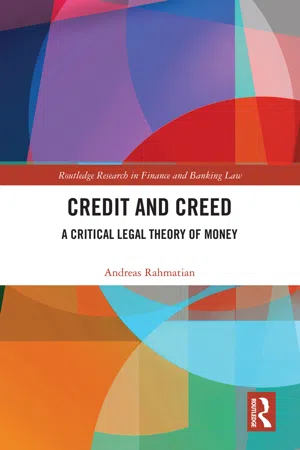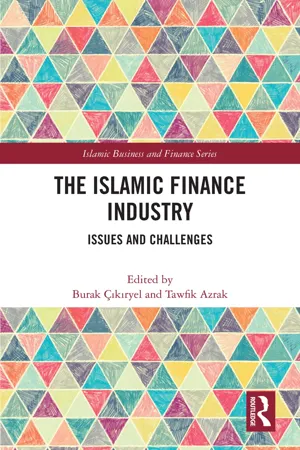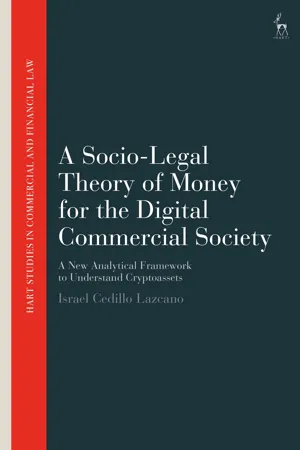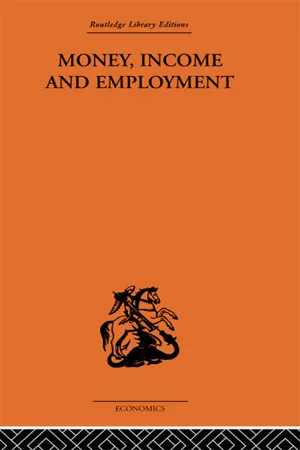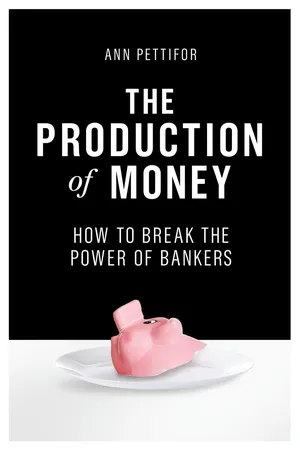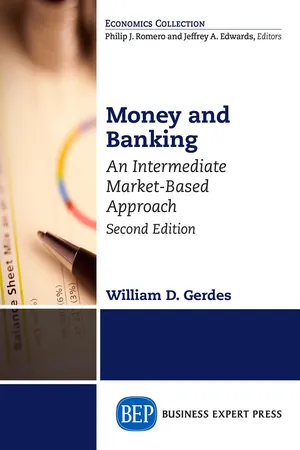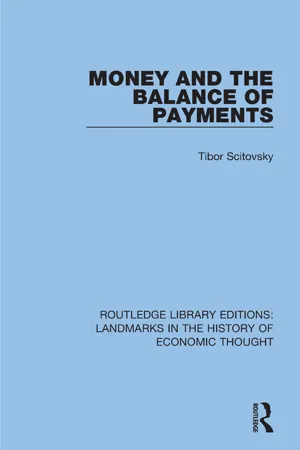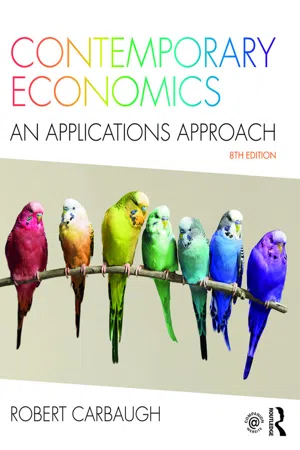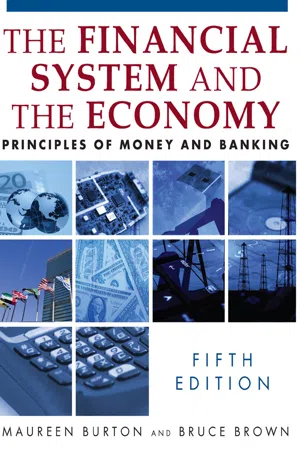Economics
Multiple Deposit Creation
Multiple deposit creation refers to the process by which banks can create money through the issuance of loans. When a bank lends money, it effectively creates a new deposit in the borrower's account, which can then be used for further lending. This cycle of lending and re-depositing allows for the expansion of the money supply beyond the initial deposit.
Written by Perlego with AI-assistance
Related key terms
10 Key excerpts on "Multiple Deposit Creation"
- eBook - ePub
Credit and Creed
A Critical Legal Theory of Money
- Andreas Rahmatian(Author)
- 2019(Publication Date)
- Routledge(Publisher)
31 but it does not explain properly the money creation process and should not be given too much emphasis.27 Bank of England (2014a: 14–15).28 Werner (2016: 370).29 Howells and Bain (2005: 241).30 Bank of England (2014a: 15).31 See e.g. Crowther (1946: 45). See also below under sec. 3(b).(c) Credit creation theory of moneyThe credit creation theory of money denies any correlation between money in depositors’ deposits and money provided by loans and therefore emphasises that banks do not use customers’ deposits to grant loans. In contrast, banks create money by giving credit: ‘Whenever a bank makes a loan, it simultaneously creates a matching deposit in the borrower’s bank account, thereby creating new money’.32 Banks are not financial intermediaries at all, neither individually (financial intermediation theory) nor in aggregate (fractional reserve theory). Schum-peter describes the money creation process in this way:33It is much more realistic to say that the banks ‘create credit’, that is, that they create deposits in their act of lending, than to say that they lend deposits that have been entrusted to them…. The theory to which economists clung so tenaciously makes [depositors] out to be savers when they neither save nor intend to do so; it attributes to them an influence on the ‘supply of credit’ which they do not have.The credit creation theory is not the newest of the three theories of money supply; it can rather be traced back to the nineteenth century and was only eclipsed by the other two theories, particularly after the Second World War. In the eighteenth century, ‘credit’ was still associated with moral ideas of ‘trust’ and ‘confidence’ between businessmen, not just with legal claim or debt, for example in the Essay on Credit by Pelatiah Webster of Philadelphia (1786):34 - eBook - ePub
The Islamic Finance Industry
Issues and Challenges
- Burak Çıkıryel, Tawfik Azrak, Burak Çikiryel, Tawfik Azrak(Authors)
- 2023(Publication Date)
- Routledge(Publisher)
Let’s assume, at time t =0, Trader A has $100 in cash. He lends out all this amount as he is not subjected to a required reserve ratio. After three steps, there is still $100 cash in the system, total loans created is $300, and the total amount borrowed is $300. If we compare this situation with the one in the banking system, the total loan amount is slightly higher (because of the absence of the required reserve ratio), and there was no deposit creation. As Menger (2009) pointed out, if a bank begins to decrease deposit creation, the gap would be immediately filled by a competing bank, or, if this is not possible, the commerce will create for itself other media of circulation to settle transactions, which will take the place of deposits (Menger, 2009). However, the most crucial difference between these two examples is that when banks grant loans and create deposits, this increases the money supply and disturbs the stability of the economy’s unit of account. In terms of money supply, at the end of the second example, the total cash amount still equals $100. However, at the end of first example, through money creation, total deposits amount is $346.61 that is readily to be spent. Figure 2.2 Creation of Loans by Traders. Source: Authors. For the deposit multiplication example of the banking system, we assume a cash amount of $100 is deposited in the first place. However, credit creation theory asserts that there is no need for that. A researcher conducted an empirical study with a local bank in Germany to see how banks channel funds for lending. The bank’s manager confirmed that neither he nor the bank’s staff checked either before or during the granting of the loan whether they keep sufficient funds with the central bank. Furthermore, the bank also did not undertake any transfers or account bookings in order to finance the credit balance (Werner, 2014). This phenomenon is peculiar to banks - eBook - ePub
A Socio-Legal Theory of Money for the Digital Commercial Society
A New Analytical Framework to Understand Cryptoassets
- Israel Cedillo Lazcano(Author)
- 2024(Publication Date)
- Hart Publishing(Publisher)
168Thus, one cannot say that saving, by itself, creates funds available for banks to lend.169 When a bank receives a loan application, it does not peer into its vault to determine the quantity of depositors’ funds are on hand to lend to third parties, as described in United Dominions Trust v Kirkwood,170 and it does not typically do so by giving them thousands of pounds’, dollars’ or pesos’ worth of banknotes.171 In practice, banks hold only cash enough to process their legal obligations – eg those that derive from the Basel Accords – and, under a FMC model, they fund new loans by creating new ledger-entry deposits for their borrowers, through ‘transactions that involve a single-cum-depositor and no saver’.172 For this reason, James Tobin173 put the ‘money created by bankers’ fountain pens’ and the ‘money created by public printing presses’ at the same level. Through this new lending, the balance sheets of different sectors of the economy are affected. In the books, this transaction appears as an asset and a liability of the bank as described with detail in Folley v Hill,174 on the one hand, and an asset and a liability of the borrower, on the other.175Figure 5 Balance sheet of commercial banks and consumers during the process of broad money creation176Figure 5 shows us how, in principle, banks create their own funding in the act of lending. No real resources are diverted from other uses in order to be able to lend to a new customer. This purchasing power is injected into the economy independently of the economy’s pre-loan income flow.177 In simpler terms, what is needed in an FMC model from third parties is not a deposit of tangible assets, but the acceptance of the new dematerialised purchasing power in payment for physical resources.178 - eBook - ePub
- Erich Schneider(Author)
- 2013(Publication Date)
- Routledge(Publisher)
(33)33 The reader is urged to consult the work of E. Preiser “Der Kapitalbergriff und die neuere Theorie” in Die Unternehmung im Markt, essays in honour of Wilhelm Rieger, Stuttgart, 1954. Further: H. Gestrich, loc. cit. , pp. 79-101.As we have seen, deposit money is also continuously created and destroyed in the course of the banks’ passive business. But if payments habits in the non-banking sector remain unchanged this can never lead to a growth in the total volume of deposit money. Growth in the total volume of deposit money is possible only if the central bank makes available new cash to the commercial banks.(34)34 This state of affairs is described as follows in “The Federal Reserve System: Its Purpose and its Functions”, published by the Board of Governors of the Federal Reserve System (Washington, D.C., 3rd edition, 1954): “Taking the banking system as a whole deposits originate in bank loans and investments, but each individual bank’s ability to lend and invest arises largely from deposits brought to it by its customers” (p. 21). In this context “investments” refer to the acquisition of assets by the banks which do not arise from loans to customers (for example, purchases of securities on the Stock Exchange). Loans, in this context, refer to the claims which a bank acquires in the course of its active business. In the famous Macmillan Report (Report of the Committee on Finance and Industry, London 1931) the same state of affairs is explained as follows: “It is not unnatural to think of deposits of a bank as being created by the public through the deposits of cash.... But the bulk of the deposits arise out of the action of the banks themselves, for by granting loans, allowing money to be drawn on an overdraft, or purchasing securities a bank creates a credit in its books which is the equivalent of a deposit” (loc. cit. - eBook - ePub
The Production of Money
How to Break the Power of Bankers
- Ann Pettifor(Author)
- 2017(Publication Date)
- Verso(Publisher)
private banking system. Rather than banks acting as intermediaries and lending out deposits that were placed with them, it is the act of lending itself that creates deposits or bank money, and is also a debt, the Bank’s staff explained. Of course this bank money is not actually printed by the private bank; only the central bank has the legal authority to print money and mint coins. The money created by a loan – bank money – is simply digitally transferred from one private bank account to another. The only evidence of its existence is in the numbers printed on a bank statement. Of the total amount of money created, only a tiny proportion is normally converted into tangible money in the form of notes and coins, or cash.For private commercial bankers operating within a monetary economy, the relevant consideration is not the availability of existing savings, but the viability of the borrower, her project, her collateral and the assessment of whether the project will generate income with which she can repay the credit/debt.And yes, the Bank of England confirmed that in a monetary economy the money multiplier (the percentage of deposits that banks are required to hold as reserves against lending) is an incorrect account of the lending process. Bank lending is not constrained by ‘reserves’. The assumption that banks hold reserves equal to a fraction of their lending – ‘fractional reserve banking’ – is wrong. Bank ‘reserves’ are not savings in the sense we understand them. They are resources (resembling an overdraft) made available only to the bankers licensed by the central bank. They are used to facilitate the ‘clearing’ process for settling deposits and liabilities between banks at the end of each day. Central bank reserves never leave the banking system to enter the real economy. While central bank reserves may help to free up the balance sheets of banks and other associated financial institutions, they cannot be used to lend on to firms or individuals in the non-bank economy. - eBook - ePub
Money
What It Is, How It's Created, Who Gets It, and Why It Matters
- Sergio M. Focardi(Author)
- 2018(Publication Date)
- Routledge(Publisher)
Let’s now explain the process of endogenous money generation. Both the verticalist approach of the money multiplier and the horizontalist approach of endogenous money generation assume the same two-tier banking system formed by commercial banks and a central bank, the latter being the bank of banks. The central bank has an account open for each commercial bank whose deposits with the central bank are called reserves. Reserves are a special form of money exchanged between commercial banks or between commercial banks and the central bank.In aggregate, commercial banks cannot affect the total amount of reserves; only the central bank can do so, increasing the global amount of reserves either by buying assets from commercial banks or by lending reserves to commercial banks. If the central bank buys assets from a commercial bank, it credits the amount of the sale to the reserve account of the commercial bank. The new reserves are created ex nihilo , the central bank simply changing the value of the reserve account of the bank from which it bought the asset. A central bank can reduce reserves performing the opposite operation, that is to say, selling assets to commercial banks or through the repayment of a reserve loan.New money is created when a client requests a loan. If the bank judges the client creditworthy, it simply creates contemporaneously the loan, which becomes an asset of the bank, and credits the corresponding deposit in the client’s account, which then becomes a liability of the bank. With computers, money creation consists simply in changing the value of the client’s account.In both approaches – the multiplier and endogenous money creation approach – a commercial bank creates a deposit ex nihilo - eBook - ePub
- William D. Gerdes(Author)
- 2017(Publication Date)
- Business Expert Press(Publisher)
The pass-through payment is shown on the T-account for Bank D. This clearing bank now has a larger deposit balance at the Federal Reserve Bank, but also has an increase in its deposit liabilities (DD√). This increased checking account balance is owned by the security dealer firm (Firm D), and represents the pass-through payment from the clearing bank to Firm D. The T-account for Firm D now shows both the increase in its deposit balance at Bank D and a reduction in its holdings of U.S. government securities.Open Market Operations and the Money SupplyCommercial bank balances at Reserve Banks (or member bank deposits, MBD) count as bank reserves. When the Federal Reserve pays for securities by increasing these balances, the total volume of reserves in the banking system increases. Because banks need reserves in order to make loans, banks are now in a position to extend more credit.This has important implications for the money supply. When banks make additional loans, the money supply increases. Indeed, in a world of fractional reserve banking, there will be a multiple expansion of bank credit. In the above example, the raw material for such a multiple expansion of bank deposit money appears in the form of additional bank reserves at Bank D.The world of fiat money is a world of inflation, and this secular decline in the purchasing power of money largely is the consequence of government expansion of the money supply. For many market-oriented economies in the industrial world, expansion the money supply occurs mainly through such open market purchases. In these economies, open market operations now serve as the “printing press.”Open market purchases (and sales) of securities affect the base money equation (4.9). Federal Reserve purchases increase TS (a factor of increase), with the offsetting entry an increase in base money (B). In the basic money supply model (4.2), the increase in B results in an increase in M1. The multiple expansion of deposit money occurs through the workings of the money multiplier, which is larger than one in a world of fiat money and fractional reserve banking. The impact of those changes on equation (4.2) is shown below. - eBook - ePub
- Tibor Scitovsky(Author)
- 2016(Publication Date)
- Routledge(Publisher)
Q of money. Continuing this process brings the total of money in the hands of the public to:2When there are n deposit banks, of which the jth maintains a reserve ratio qj and receives on deposit a fraction Pj of the public’s total holdings of money, the total amount of money is given by the expression:Since the several banks in the same economy usually maintain the same reserve ratio, q, the above expression can be simplified to:(1) where is the proportion of its money holdings the public chooses to hold on deposit with banks in general.The above expressions show, M, the total amount of money (i.e., cash and bank deposits) created given the amount of cash, Q; and they show M to be a multiple of Q, considering that the q’s, the p’s, and ∑ p are all positive fractions. In the United States at the end of 1966, equation (1) had the following value:The ratio of M to Q (2.8 in the above equation) is sometimes called the credit multiplier. It shows the leverage with which the monetary authority can, by changing Q, the supply of money it creates, induce a change in M, the total quantity of money in the hands of the public. As already mentioned, the monetary authority can also change M by changing q, the banks’ reserve ratio.The establishment of an (n +1)th deposit bank, offering customers the same facilities and maintaining (or compelled by the monetary authority to maintain) the same reserve ratio as the other n banks, would not add to the quantity of money, because its establishment would not raise ∑ p - No longer available |Learn more
Contemporary Economics
An Applications Approach
- Robert Carbaugh(Author)
- 2016(Publication Date)
- Routledge(Publisher)
- A commercial bank is a corporation that seeks to make a profit for its stockholders. Among the most important assets of a bank are its reserves, loans, and government securities. Deposits and borrowings are a bank’s major liabilities.
- Most of our money comes from checking accounts issued by banks, rather than currency. Through the process of lending reserves, banks create money. The money multiplier is used to calculate the maximum amount of money that the banking system can generate with each dollar of reserves. The money multiplier is the reciprocal of the required reserve ratio.
- The FDIC has been insuring deposits and promoting safe and sound banking practices since 1933. The FDIC insures deposits up to $250,000 at virtually all U.S. banks. Since the formation of the FDIC, not one depositor has lost a cent of insured funds because of bank failure.
Key Terms and Concepts
- money (333)
- currency (333)
- medium of exchange (334)
- unit of account (334)
- store of value (334)
- demand deposit account (340)
- negotiable order of withdrawal (NOW) account (340)
- certified check (342)
- cashier’s check (342)
- money order (342)
- traveler’s checks (342)
- Federal Reserve (343)
- correspondent bank (343)
- clearinghouse corporation (343)
- legal tender (345)
- M1 money supply (347)
- compound interest (348)
- balance sheet (350)
- reserves (350)
- required reserves (351)
- actual reserves (351)
- excess reserves (351)
- required reserve ratio (351)
- money multiplier (353)
- Federal Deposit Insurance Corporation (FDIC) (354)
Study Questions and Problems
-
Analyze each of the following assets in terms of their potential use as a medium of exchange, a unit of account, and a store of value. Which use is most appropriately associated with each asset?
- A Visa credit card
- A $20 Federal Reserve note
- 10 shares of Microsoft stock
- A 90-day Treasury bill
- A certificate of deposit at a commercial bank
- A checking account at a savings and loan association
- $20 worth of dimes
- Table 14.5
- eBook - ePub
The Financial System and the Economy
Principles of Money and Banking
- Maureen Burton, Bruce Brown(Authors)
- 2014(Publication Date)
- Routledge(Publisher)
Remember that depository institutions are firms, and like all other firms, they are interested in maximizing profits. Given this objective, firms will consider the costs and revenues associated with alternative courses of action, such as lending versus not lending or borrowing reserves versus not borrowing reserves. The multiplier model simplifies away such notions. In particular, the cost of deposits and the return on loans—in other words, interest rates—were ignored. We simply assume that depository institutions always have customers ready, willing, and able to borrow.The model also fails to consider the creative ways in which banks and other depository institutions get around reserve requirements when the banking system is demanding more reserves than the Fed is willing to supply. The Eurodollar market is a prime example of a way that a bank can change a deposit liability with its corresponding reserve requirement into a nondeposit liability free of a reserve requirement. Credit extension can continue, even without the Fed feeding additional reserves into the system.Given the preceding clarifications, some economists suggest that teaching this multiplier model should be done only from a historical perspective. They believe that in the complex financial system today, the model is merely a historical artifact with little relevance to the way depository institutions behave. We believe that if it is viewed with caution, the model gives some insight into the workings of the banking system.In the next chapter, we look at the demand for money and credit. We also put demand and supply together to see how the public, the Fed, and the banking system jointly interact to determine a money market equilibrium. This chapter contains two appendices. The first is on other factors that affect the monetary base. The second develops the relationship between changes in the monetary base and changes in M 2 (the M
Index pages curate the most relevant extracts from our library of academic textbooks. They’ve been created using an in-house natural language model (NLM), each adding context and meaning to key research topics.
